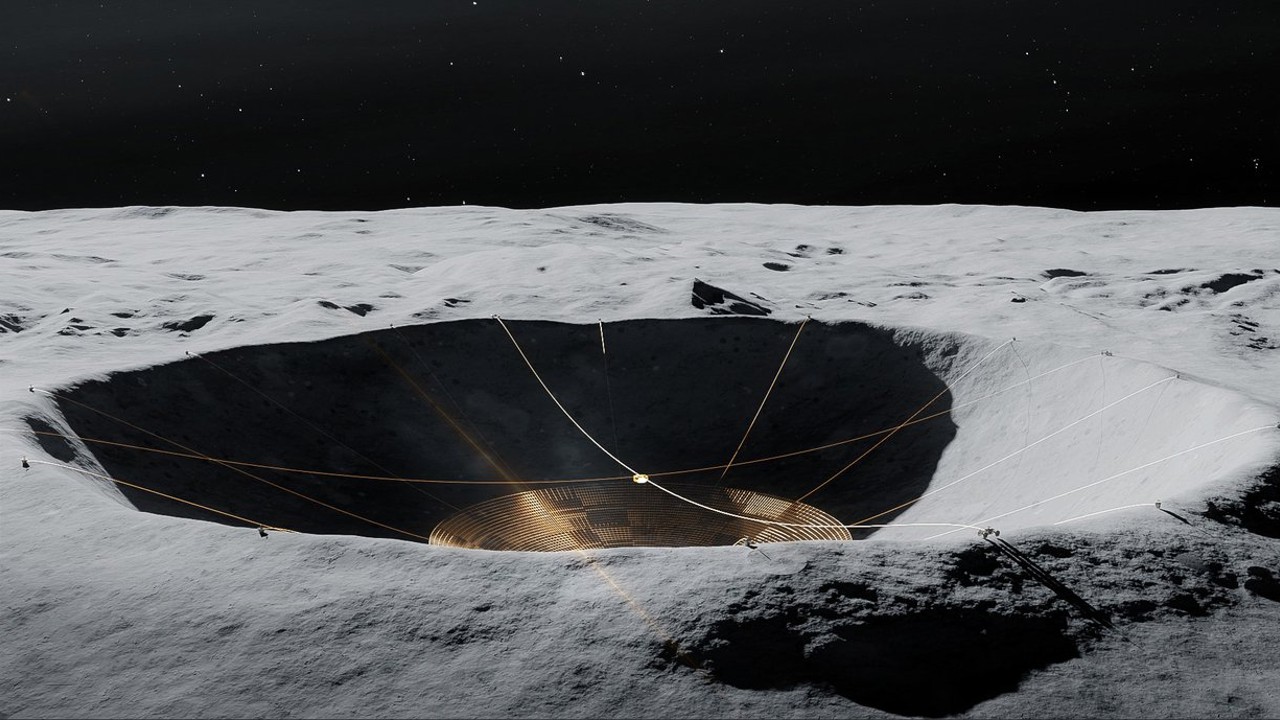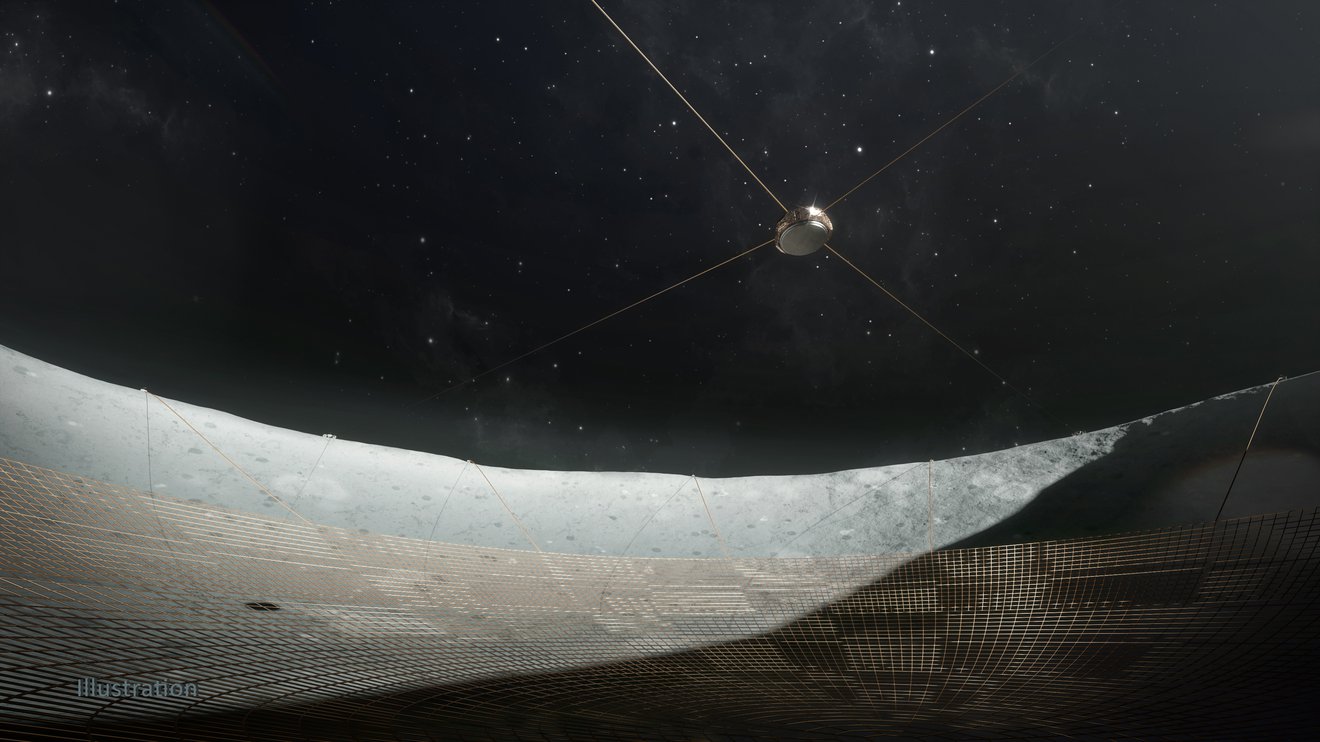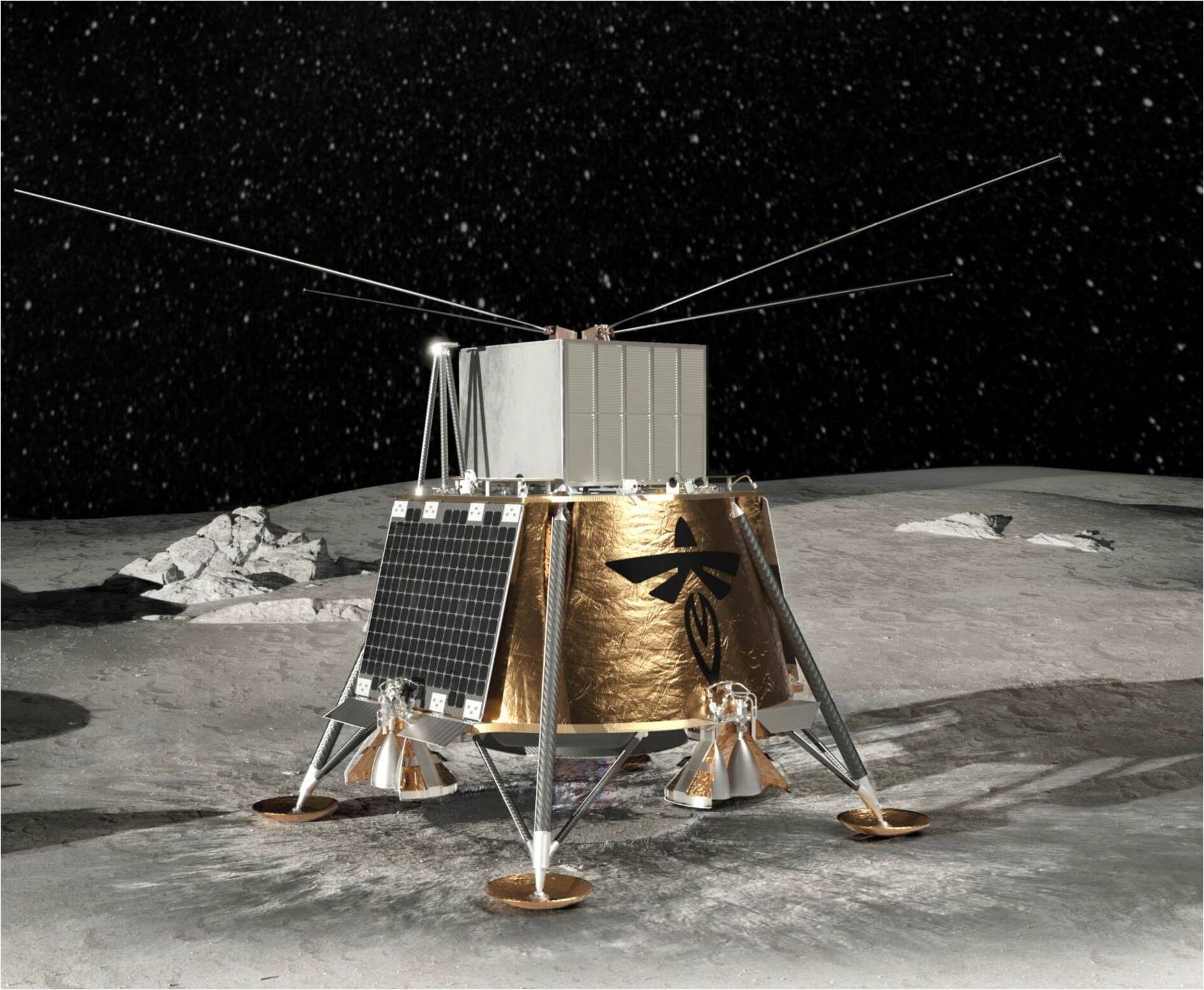
The moon could be perfect for cutting-edge telescopes — but not if we don't protect it
"We are entering a new era of science investigations from our nearest neighbor in space."

Space scientists are eager to protect the option of doing astronomy from the moon.
There are plans in the works to place astronomical hardware on the lunar landscape such as super-cooled infrared telescopes, a swath of gravitational wave detectors, large Arecibo-like radio telescopes, even peek-a-boo instruments tuned up to seek out evidence for "out there" aliens.
Yes, the future of lunar astronomy beckons. But some scientists say there's an urgent need to protect any moon-based astronomical equipment from interference caused by other planned activities on the moon, ensuring they can carry out their mission of probing the surrounding universe.
To that end, efforts are ongoing to scope out and create policy in conjunction with the United Nations in the hope of fostering international support for such protections.
Related: Gravitational wave detectors on the moon could be more sensitive than those on Earth
Global agreements
This action plan is spearheaded by the International Astronomical Union (IAU). The IAU brings together more than 12,000 active professional astronomers from over 100 countries worldwide.
Richard Green is chair of the IAU group specific to looking at the issues of staging astronomy from the moon. He is also an assistant director for government relations at Steward Observatory, run by the University of Arizona in Tucson.
Get the Space.com Newsletter
Breaking space news, the latest updates on rocket launches, skywatching events and more!
The IAU working group is aiming to collaborate with a number of other non-governmental organizations to protect the option of doing astronomy from the moon, Green tells Space.com.
A number of participants in the IAU working group are spectrum managers from radio observatories, strongly linked to the International Telecommunication Union (ITU) and ITU's World Radiocommunication Conference, a treaty-level forum to review and revise, if necessary, radio regulations and global agreements regarding use of the radio-frequency spectrum and the geostationary-satellite and non-geostationary-satellite orbits.
The working group members want to maximize the range of protected frequencies, "including the very low frequencies needed to study the early universe and auroral emissions from planets," Green says.
Equitable access
The other approach, says Green is for protection of sites on the moon that might be suitable for cooled infrared telescopes or gravitational wave detector arrays.
"We have common cause with those who want to protect historical legacy sites and even those who want dedicated sites for extracting water or minerals," Green says. "We imagine that the United Nations Committee on the Peaceful Uses of Outer Space is the venue in which some process can be developed to claim a site for protection and to resolve competing claims."
The IAU Astronomy from the moon working group has space law and policy experts who can provide a strong basis for that approach, Green says.
"Of course, the main goal is to conduct astronomical observations that can be uniquely done from the moon," Green explains. The working group is embracing the expertise of principal investigators of lunar missions or concepts for missions.
Doing so, Green says, can help engage the astronomical community in prioritizing sites of extreme scientific interest and take in issues of conducting science in an environment for which "equitable access" is anchored in the spirit of the United Nations 1967 Outer Space Treaty.

Clearly required
A thumbs-up approval of the IAU initiative is Ian Crawford, a professor of planetary science and astrobiology at Birkbeck College, London.
"My own view is that a subset of lunar locations, for example specific polar craters and key far side locations, need to be designated as 'Sites of Special Scientific Importance' and protected as such, Crawford told Space.com.
A possible model, Crawford suggests, might be the Antarctic Specially Protected Areas (ASPAs) as defined in Annex V of the Environmental Protocol to the Antarctic Treaty.
"In any case, international coordination is clearly required so United Nations involvement appears entirely appropriate," Crawford says.
Private partnerships
NASA is working with several U.S. firms to deliver science and technology to the moon's surface by way of the Commercial Lunar Payload Services (CLPS) initiative.
Given the uptick in future CLPS-enabled robotic lunar exploration, we are about to the see the first NASA-funded science payloads landed there in over 51 years — since the Apollo 17 human moon landing in December 1972, says Jack Burns, professor emeritus in the department of astrophysical and planetary sciences at the University of Colorado, Boulder.
One payload, for which Burns serves as co-investigator, is called the Radio Wave Observations on the Lunar Surface of the photoElectron Sheath (ROLSES). If successful, it would be the first radio telescope on the moon and situated at the lunar south pole. ROLSES is to be emplaced there in February via the Intuitive Machines Nova-C lunar lander's IM-1 mission under the CLPS partnership.

This will be followed in two years by the Lunar Surface Electromagnetics Experiment-Night, or LuSEE-Night, slated to fly in 2026 aboard the Firefly Aerospace Blue Ghost Mission-2 lander. This endeavor is also part of the CLPS undertaking and Burns is a science team member of the LUNAR far side experiment.
LuSee-Night is a radio telescope that will look into the never-before seen dark ages of the early universe — a time before the birth of the first stars.
Science fact
With this potential and promising burgeoning of radio astronomy from the moon, Burns says "it is essential that we now develop international agreements to protect the far side of the moon for radio astronomy as it is the only truly radio-quiet site in the inner solar system."
Burns emphasizes that radio observations from the moon are no longer science fiction but science fact.
"We are entering a new era of science investigations from our nearest neighbor in space," Burns says.
Join our Space Forums to keep talking space on the latest missions, night sky and more! And if you have a news tip, correction or comment, let us know at: community@space.com.

Leonard David is an award-winning space journalist who has been reporting on space activities for more than 50 years. Currently writing as Space.com's Space Insider Columnist among his other projects, Leonard has authored numerous books on space exploration, Mars missions and more, with his latest being "Moon Rush: The New Space Race" published in 2019 by National Geographic. He also wrote "Mars: Our Future on the Red Planet" released in 2016 by National Geographic. Leonard has served as a correspondent for SpaceNews, Scientific American and Aerospace America for the AIAA. He has received many awards, including the first Ordway Award for Sustained Excellence in Spaceflight History in 2015 at the AAS Wernher von Braun Memorial Symposium. You can find out Leonard's latest project at his website and on Twitter.
-
Fission Thank you for the reminder that what has driven us to explore outer space is the search for knowledge. What exactly is out there when we look up at the heavens. There is so much yet to explore. Unfortunately, NASA appears to have sold out to commercial interests that promote colonization of the Moon and Mars. They have literally claimed that they are building an escape hatch from Earth for when we ruin the planet in the future. Let's be honest - if we reach that point it is game over. What they are building is a boondoggle for private, commercial interests that will provide little benefit.Reply
We have only begun to scratch the surface of the Moon. Let's wait awhile before we alter the surface of the Moon as we have done to the Earth. Lunar missions should be limited to scientific exploration. All commercial exploitation and military installations on the Moon should be banned at this time. -
Cdr. Shepard Reply
Chill out, comrade. Before you seize the means of production, note that without private aerospace, we would not be going to the moon, or Mars, or beyond until you and I were long dead.Fission said:Thank you for the reminder that what has driven us to explore outer space is the search for knowledge. What exactly is out there when we look up at the heavens. There is so much yet to explore. Unfortunately, NASA appears to have sold out to commercial interests that promote colonization of the Moon and Mars. They have literally claimed that they are building an escape hatch from Earth for when we ruin the planet in the future. Let's be honest - if we reach that point it is game over. What they are building is a boondoggle for private, commercial interests that will provide little benefit.
We have only begun to scratch the surface of the Moon. Let's wait awhile before we alter the surface of the Moon as we have done to the Earth. Lunar missions should be limited to scientific exploration. All commercial exploitation and military installations on the Moon should be banned at this time.
We scratched the surface over half a century ago and nothing has been done since. Your assertion that private "boondoggles" -- which alone indicates you don't understand the definition of "boondoggle" -- will provide little benefit is entirely baseless. There is indeed so much yet to explore that would remain unexplored for centuries if you were running the show. The protection of sites deemed of high scientific importance should be undertaken; it will also likely be industry players like SpaceX that gets those projects on-site at reasonable cost and on a reasonable timeline. It seems your opinion is rooted in emotion and ignorance rather than justifiable concern for the lunar environment, which has been left 99.999999% unaltered by human activity and will remain so for hundreds of years even if assuming the most optimistic of timelines for commercial development. Do you not fundamentally understand how difficult it would be to even "ruin" a patch of the lunar surface with a lunar base that could support a small town's population? Do you not understand that Artemis II & III are so often and reliably delayed that we'll be lucky to have fewer than 10 total boots on the regolith before 2030?
NASA hasn't "sold out" to private interests, and in fact, they could stand to manage the use of US taxpayers' earned income a bit more responsibly instead of throwing it at Boeing / Lockheed, enriching their lobbyists while burdening us with absolutely laughable cost-overruns for projects that aren't completed for a decade beyond target timing. Perhaps you prefer SLS (See: Boondoggle) do all the heavy lifting in space, so that none of this comes to fruition...ever. That would certainly preserve the lunar environment indefinitely, as you wish. -
Fission Reply
You clearly capture the problem: "we would not be going to the moon, or Mars, or beyond until you and I were long dead." If one examines the issue of space exploration you would come to the conclusion that is the best outcome possible. You obviously are all in on the boondoggle which means: "a wasteful and worthless project undertaken for political, corporate, or personal gain, typically a government project funded by taxpayers." The benefit of funding manned missions to the Moon and Mars is left for the taxpayer to imagine. It will cost at least tens if not hundreds of billions of dollars to accomplish the mission that we as taxpayers will have to support. That mission also carries the possibility of catastrophic failure.Cdr. Shepard said:Chill out, comrade. Before you seize the means of production, note that without private aerospace, we would not be going to the moon, or Mars, or beyond until you and I were long dead.
We scratched the surface over half a century ago and nothing has been done since. Your assertion that private "boondoggles" -- which alone indicates you don't understand the definition of "boondoggle" -- will provide little benefit is entirely baseless. There is indeed so much yet to explore that would remain unexplored for centuries if you were running the show. The protection of sites deemed of high scientific importance should be undertaken; it will also likely be industry players like SpaceX that gets those projects on-site at reasonable cost and on a reasonable timeline. It seems your opinion is rooted in emotion and ignorance rather than justifiable concern for the lunar environment, which has been left 99.999999% unaltered by human activity and will remain so for hundreds of years even if assuming the most optimistic of timelines for commercial development. Do you not fundamentally understand how difficult it would be to even "ruin" a patch of the lunar surface with a lunar base that could support a small town's population? Do you not understand that Artemis II & III are so often and reliably delayed that we'll be lucky to have fewer than 10 total boots on the regolith before 2030?
NASA hasn't "sold out" to private interests, and in fact, they could stand to manage the use of US taxpayers' earned income a bit more responsibly instead of throwing it at Boeing / Lockheed, enriching their lobbyists while burdening us with absolutely laughable cost-overruns for projects that aren't completed for a decade beyond target timing. Perhaps you prefer SLS (See: Boondoggle) do all the heavy lifting in space, so that none of this comes to fruition...ever. That would certainly preserve the lunar environment indefinitely, as you wish.
It seems that the debate over the advantages of unmanned missions vs manned has been skipped over. Unmanned missions have been incredibly successful over the past 50 years. That is because they are dedicated to scientific discovery. Just look at the results. There are three benefits to manned explorations: the commercialization of space; the militarization of space; and the fulfillment of overblown science fiction fantasies.









